Oh ho a bread post!
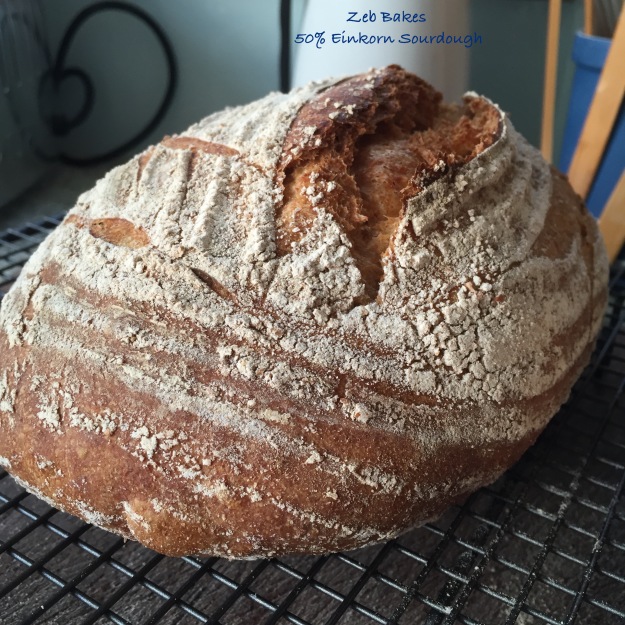 Einkorn is one of the older forms of wheat that is cultivated in a domestic form to this day.
Einkorn is one of the older forms of wheat that is cultivated in a domestic form to this day.
Once upon a time I hand ground some einkorn grain that my friend Mandy brought me from Germany and made a loaf with it and wrote a little post about it. That long ago loaf looked like this
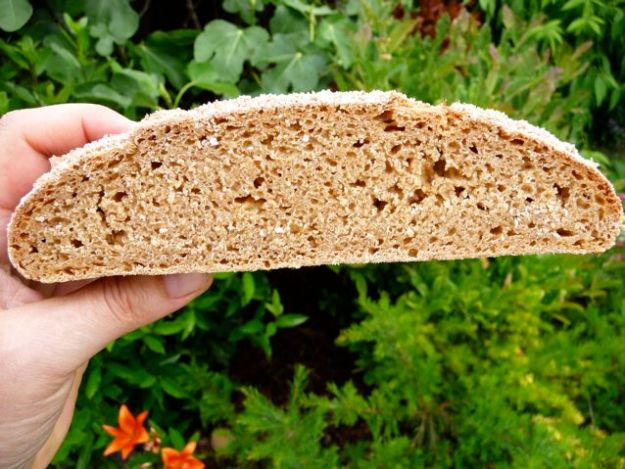
An early attempt at making einkorn bread
In French this grain is called petit épautre and in English einkorn or little spelt, and in Italian piccolo farro or so Wikipedia tells us. Wikipedia also claims it is not good for making bread but I am currently making a 50/50 regular wheat/einkorn sourdough which rises well enough for me! It is more expensive to buy than ordinary bread flour, no doubt because the threshing is more difficult and the yields are lower and it is probably not grown in huge quantities for bread making purposes. From a value point of view it is quite a good idea to mix it with some less expensive bread flour and also you will then get a bit of lift from the gluten in the more modern flour. In the UK the easiest place to get hold of einkorn is from a store that stocks Dove Flours or online.
Whatever your reasons for using alternative flours, taste and texture figure strongly in my choices.
I like the softer crumb that using these older flours gives in the sourdough without having to go down the souped up high hydration porridge route of bread making which seems popular these days. I am lazy and like to work with a hydration of not much more than 68-70%. I have in the past risen to the challenge of making liquid doughs into bread, but I much prefer to be able to shape the dough easily and quickly and into a banneton and leave to rise and then bake it off without having to chill it first to get it to hold shape long enough to get it in the oven, or heat large heavy metal pots to dump it in, so the sides contain it and help it to rise, all things done successfully by younger and fitter bakers than me for the most part in their quest for soft squeezable sourdough crumbs.
I like the homogeneity of the flour too. There are no big particles or flakes of bran in the flour to cut through the gluten in the dough and I don’t miss the dusty taste of bran in the bread, some people love it, some not so much. A lot of the wholegrain flour that is offered for sale here is full of large particles of bran and often I sift wholemeal flour to remove the larger bits and then try and whizz them smaller, it doesn’t work very well. I think it is the English style, dating back to that whole thing about bran being roughage and oh so good for you. I think soluble fibre is far easier on the gut and foods like butternut squash are a good source of this and other vegetable fibres rather than high bran breads which have the reverse effect on me to that which they are reputed to have! I wish they would mill and sift the wholemeal flours more finely but that is a personal thing I guess.
But as I have always said, we eat the bread we like and if we can’t buy the bread we like then we need to figure out how to make something that pleases us and our tums and those who we feed too and if we can’t make it, then find a baker who makes something you like and worry not. I don’t know how it is where you live but cities like Bristol where I live have a growing and lively food culture and there are far more artisan bakers than there were ten years ago. I celebrate them all and buy a loaf or a savoury treat when I am nearby.
Unfortunately I can’t embed the interactive BreadStorm formula onto this sort of a blog as it is hosted by WordPress. But you can find the interactive formula by going to this link on the BreadStorm server where I have uploaded it. And you can find out more about BreadStorm here. It suits me very well as i am a Mac user.
Here are two snapshots (pdfs) of the formula, one giving the bakers’ percentages, the other the weights that I use most often
and
1c 50% Einkorn Sourdough (weights)
Old school style here is the formula for you too
Levain
50g of active starter
200g bread flour
250g water
When fully fermented (see notes) use the levain together with
437 – 480 g water
310g bread flour
494g einkorn flour
19g seasalt
to make the final dough
These quantities give you approximately 3 lbs of dough or 1.75 kg in metric.
Finally my rather stripped down notes to self based as is often the case on the work of Jeffrey Hamelman in Bread. The formula is also based on his sourdough and proportions. If you like a really strong sour then this is not one for you and you will need to use the proportions of starter to new flour that give you the higher levels of acidity that you desire.
If you want more help with sourdough in general then have a look at some of my other posts or visit The Fresh Loaf or any of the wonderful bloggers who write for love of bread and are listed in the links page on my blog.
- Mix all ingredients except salt to shaggy mass, adjust water,
- I usually end up adding about another 40g of water at this point but depends on how absorbent the flours are and whether you like a looser or a tighter dough to work with
- Autolyse for 20 – 30 mins
- Add salt and mix in well
- Bulk Fermentation 2.5 – 5 hours hours
- Fold dough twice
- I tend to make three small loaves these days, 2 x 600 and one smaller one with the leftover dough, about 500 g as they fit on my oven stone (as in the image below) and each loaf gives enough for toast and a lunch sandwich for two people.
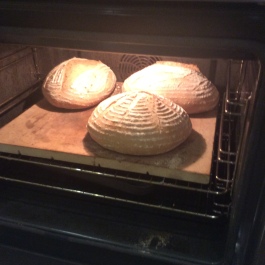
- I freeze the other two and eat them over the next ten days or so.
- Final Fermentation – 2- 4 hours depending on room temperature, the cooler the room the longer it takes
- or fridge for up to 18 hours at 42 F4 C
- Bake with steam at 230 C for the first ten minutes if you want a rich dark crust and then for a 1kg loaf at least another 45 minutes at 200-220 C, less for smaller weights, my 600g loaves take about 45-50 minutes in total
NB: This bread uses Carrs Bread flour and Doves Einkorn, both available in the UK

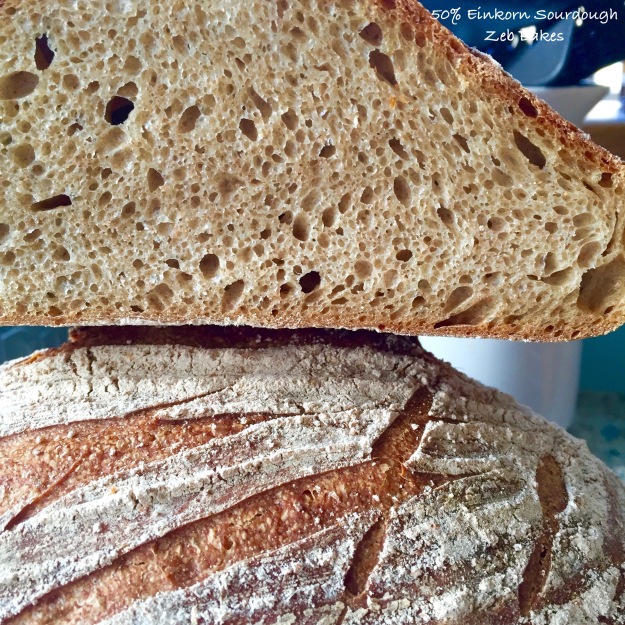
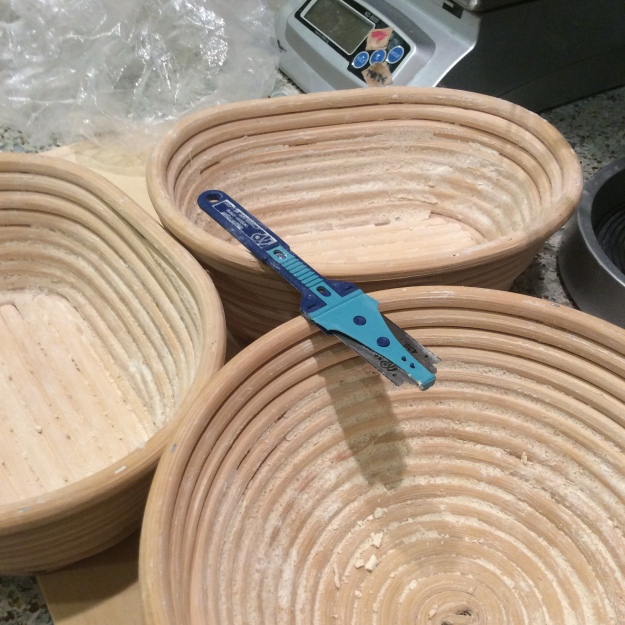
Wonderful post! I have to say a lower hydration dough is pretty nice to work with, and I get a bit tired of the fascination with HUGE holes in bread.. I mean, don’t people enjoy a slice of bread that actually HOLDS something on top of it? ;-)
beautiful production! Hope all is going fantastic for you!
Thankyou, life is fine right now! The production of last night’s bread (above) got a bit exciting when the dough wouldn’t turn out neatly of the banetton but I spoke firmly to it and it flopped out eventually so I treated it to random slashing and hey it still turned out farily respectably :) :)
Thanks for posting this would love to attempt f I can get hold of Einkorn flour.
Fran xx
Sent from my iPad
>
I find it here in the wholefood stores. Do you have one of those somewhere accessible Fran?
Lovely! I’m glad you are still sourdough-baking. x
I love sourdough baking, the best sort for an absent minded person like me :) xx
In the wars today day off took a big load of books to the Mind charity shop . As I was crossing at the lights my trolley fell over and caught me on the back of my leg! Massively bruised . That will teach me not too overload.
Hope you and Brian Are well won’t be doing much walking now this week annoyed.!
Hugs to you and Brian and extra big hugs to Zeb handsome and lovely Lulul.
Franxxxx
Sent from my iPad
>
oh no, how horrible is that!!! I went for a swim yesterday and kicked the lane rope and bruised a toe – one doesn’t expect to bruise oneself taking books to a charity shop, or virtuously swimming. Hope you recover quickly! Big Hugs xxx
What a terrific post, Joanna! You sound so zen in your baking. I love it. Being zen is what I strive for as well these days. Your bread is beautiful with a lovely crumb. I am sharing on my FB page. I hope you don’t mind!
Thank you, what a nice thing to say. I have become so slapdash in my baking, but you could say it was ‘zen’ I suppose, the path of least resistance, go with the dough, and consume the evidence :) I am delighted that you want to share it, thank you!
Good afternoon Joanna. Thank you for this wonderful recipe, actually all yours post are great. Best regards.
Hi Luiz, you are most welcome, hope you are having a good day! all best, Joanna
I’m glad to see your success. When we return from our travels in April I have a spelt sourdough starter that I will rehydrate and use spelt flour to try my hand at bread I can eat. I’m very excited about the prospect. Gorgeous loaves and photos Joanna.
That is exciting news! I think spelt and einkorn have some characteristics in common, long live old grains :)
Saw Farine’s post on FB so had to come and have a look! Always keen to try new and interesting bread so am off to see if I can find some einkorn flour down under.
Good luck in your quest Ann, thanks for reading!
Love it when you get all geeky on the bread Joanna :-)
High hydrations, while I love the taste and soft crumb, the getting to that point drives me crazy, too sloppy, too messy…not enough bench space! So…I stick to a regular roll em out, plop them ratio.
Gorgeous looking loaf this one.
I love that ‘regular roll em out, plop them’ ratio, The emperor’s new clothes bread making method almost anti geek, though maybe one has to go through geekdom to degeek or maybe I will always be a little bit geeky xxx :) :)
Good to see you posting about bread again Joanna. As usual you write with wisdom and understanding, and I’ve learnt a thing or two I didn’t know before. I hadn’t realised that the overnight chilling in the fridge firms the loaf up – seems obvious now you say it! -but I don’t do that either as I think it increases the sourness, and I like to keep that as low as possible. I’m with you too on low hydration. I still hanker after mastering the high hydration technique though, just so I can say I can do it! Those big holes are beguiling, though ridiculously impractical :-)
I don’t know about wise and understanding, but the chilling definitely firms up dough and dries the skin of the dough a bit too, some of those razor sharp slashes one sees I think are done on cold slightly dried dough to get the look. I have chilled dough sometimes, especially if I am trying to get a sourer taste for someone, but I have never manage to get that Poilaine taste, which I hanker after, never mind. I am sure you can master the high hydration technique, have you tried the one where you add more water after mixing the initital dough, that works for some people? I just hate chasing the dough around the workbench :) :)
Bread, and just in time for me to start thinking about lighting Brunhilda again. You are a star Ms Joanna. You truly are :)
I bake in my usual chaotic way every 8-10 days or so, this time there was a dearth of bread in the house for two days and we resorted to crispbreads instead. And for some reason I decided to post this one properly as I had half written the post for Facebook already. Hope all is blooming still in Paradise, beautifully cold and crisp and golden here today, everyone has a spring in their step! :)
Crisp and golden. Sounds beautiful :)
I like einkorn a lot. Here I can get it as import from Italy, or, as I do it, mail-order the whole grain and grind them myself. Your bread has a very nice crumb – I don’t believe in the mantra “the hole-yer the better”, either.
Hi Karin!Thank you for your nice comment! I bet you have a good quality mill. I was so tempted a few years back to invest in one… The brand I have been using is this one Doves Einkorn Flour it says it is grown and milled in the UK.
Hi Joanna – love the recipe and am about to try it – but how long do you find you need to leave the levain – overnight? A few hours…? It’s not a big problem – I’ll go with the flow – but you didn’t actually mention it n the notes!
I’m also going to try using emmer flour, thought I had einkorn but duh! and my sourdough is raring to go…..!!
Hi Carol, the levain? I usually leave it about 12 hours in the winter, sometimes longer from mixing, it really depends on two things, how active the ‘seed starter’ is, i.e. whether it has been refreshed before you start building the levain or whether it has been in the fridge for a week. And it also depends very much on the temperature of the air in the space that the levain is developing in. So if your kitchen is warm i.e. about 20C or so it will develop much quicker than in a 16C kitchen, so in the summer the levain probably is ready within 6-8 hours if it is warm. I look for a good bubbly texture, with bubbles rising to the surface, and a slightly elastic feel to it still when you pick the bowl up and swirl it round. If it has gone very frothy and sort of liquid looking it has gone a bit beyond its peak, and the resultant dough will be more acidic, but you can still use it I would say for about 18 – 20 hours after mixing and it should be fine. Emmer is good too, it is a very soft flour, if you find the bread is very close textured when you make it, then next time go for less emmer to bread flour, maybe 25%. Hope this helps x Jo PS if you look at the old Everyday sourdough post that I wrote that gives much closer attention to timing and so on. This is based on that if you see what I mean. Sorry I haven’t really been blogging much of late, this was just one of those ‘after=posts’ !